Detection and Characterization of Nodularin by Using Label-Free Surface-Enhanced Spectroscopic Techniques
Abstract
1. Introduction
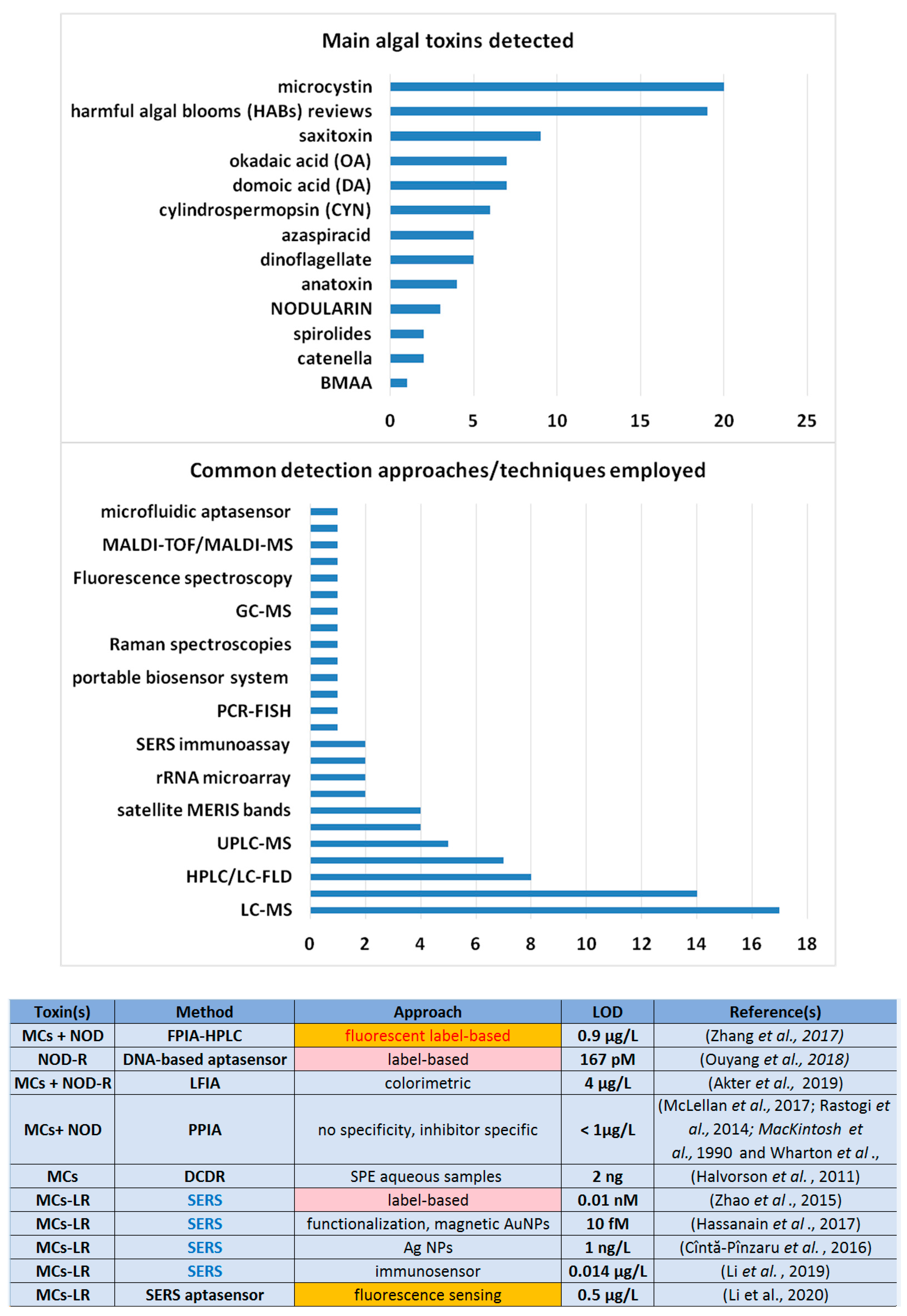
2. Results and Discussion
2.1. Raman Analysis of NOD
2.2. SERS Analysis of NOD
3. Materials and Methods
3.1. Drop-Coating Deposition Raman Analysis of NOD
3.2. SERS Measurements
3.2.1. SERS Analysis on Klarite™ Substrates
3.2.2. SERS on AgNPs
3.2.3. SERS on Substrates with Periodical Nanotrenches
3.3. Computational Details
4. Conclusions
Author Contributions
Funding
Institutional Review Board Statement
Informed Consent Statement
Conflicts of Interest
References
- Zahra, Z.; Choo, D.; Lee, H.; Parveen, A. Cyanobacteria: Review of Current Potentials and Applications. Environments 2020, 7, 13. [Google Scholar] [CrossRef]
- Rasmussen, B.; Fletcher, I.R.; Brocks, J.J.; Kilburn, M.R. Reassessing the first appearance of eukaryotes and cyanobacteria. Nature 2008, 455, 1101–1104. [Google Scholar] [CrossRef]
- Paerl, H.W.; Fulton, R.S., 3rd; Moisander, P.H.; Dyble, J. Harmful freshwater algal blooms, with an emphasis on cyanobacteria. Sci. World J. 2001, 1, 76–113. [Google Scholar] [CrossRef]
- Huisman, J.; Codd, G.A.; Paerl, H.W.; Ibelings, B.W.; Verspagen, J.M.H.; Visser, P.M. Cyanobacterial blooms. Nat. Rev. Microbiol. 2018, 16, 471–483. [Google Scholar] [CrossRef]
- Merel, S.; Walker, D.; Chicana, R.; Snyder, S.; Baures, E.; Thomas, O. State of knowledge and concerns on cyanobacterial blooms and cyanotoxins. Environ. Int. 2013, 59, 303–327. [Google Scholar] [CrossRef]
- Cazenave, J.; Wunderlin, D.A.; de Los Angeles Bistoni, M.; Ame, M.V.; Krause, E.; Pflugmacher, S.; Wiegand, C. Uptake, tissue distribution and accumulation of microcystin-RR in Corydoras paleatus, Jenynsia multidentata and Odontesthes bonariensis. A field and laboratory study. Aquat. Toxicol. 2005, 75, 178–190. [Google Scholar] [CrossRef]
- Carmichael, W.W. Health Effects of Toxin-Producing Cyanobacteria: “The CyanoHABs”. Hum. Ecol. Risk Assess. 2001, 7, 1393–1407. [Google Scholar] [CrossRef]
- Plaas, H.E.; Paerl, H.W. Toxic Cyanobacteria: A Growing Threat to Water and Air Quality. Environ. Sci. Technol. 2021, 55, 44–64. [Google Scholar] [CrossRef]
- Romanis, C.S.; Pearson, L.A.; Neilan, B.A. Cyanobacterial blooms in wastewater treatment facilities: Significance and emerging monitoring strategies. J. Microbiol. Methods 2021, 180, 106123. [Google Scholar] [CrossRef]
- Munoz, M.; Cires, S.; de Pedro, Z.M.; Colina, J.A.; Velasquez-Figueroa, Y.; Carmona-Jimenez, J.; Caro-Borrero, A.; Salazar, A.; Santa Maria Fuster, M.C.; Contreras, D.; et al. Overview of toxic cyanobacteria and cyanotoxins in Ibero-American freshwaters: Challenges for risk management and opportunities for removal by advanced technologies. Sci. Total Environ. 2021, 761, 143197. [Google Scholar] [CrossRef]
- Duy, T.N.; Lam, P.K.; Shaw, G.R.; Connell, D.W. Toxicology and risk assessment of freshwater cyanobacterial (blue-green algal) toxins in water. Rev. Environ. Contam. Toxicol. 2000, 163, 113–185. [Google Scholar] [CrossRef]
- Chorus, I.; Falconer, I.R.; Salas, H.J.; Bartram, J. Health risks caused by freshwater cyanobacteria in recreational waters. J. Toxicol. Environ. Health B Crit. Rev. 2000, 3, 323–347. [Google Scholar] [CrossRef]
- Chen, L.; Chen, J.; Zhang, X.; Xie, P. A review of reproductive toxicity of microcystins. J. Hazard. Mater. 2016, 301, 381–399. [Google Scholar] [CrossRef]
- Humpage, A. Toxin types, toxicokinetics and toxicodynamics. Adv. Exp. Med. Biol. 2008, 619, 383–415. [Google Scholar] [CrossRef]
- Ibelings, B.W.; Chorus, I. Accumulation of cyanobacterial toxins in freshwater “seafood” and its consequences for public health: A review. Environ. Pollut. 2007, 150, 177–192. [Google Scholar] [CrossRef]
- Dietrich, D.; Hoeger, S. Guidance values for microcystins in water and cyanobacterial supplement products (blue-green algal supplements): A reasonable or misguided approach? Toxicol. Appl. Pharmacol. 2005, 203, 273–289. [Google Scholar] [CrossRef]
- Lage, S.; Mazur-Marzec, H.; Gorokhova, E. Competitive interactions as a mechanism for chemical diversity maintenance in Nodularia spumigena. Sci. Rep. 2021, 11, 8970. [Google Scholar] [CrossRef]
- Gehringer, M.M.; Adler, L.; Roberts, A.A.; Moffitt, M.C.; Mihali, T.K.; Mills, T.J.; Fieker, C.; Neilan, B.A. Nodularin, a cyanobacterial toxin, is synthesized in planta by symbiotic Nostoc sp. ISME J. 2012, 6, 1834–1847. [Google Scholar] [CrossRef]
- Moffitt, M.C.; Blackburn, S.I.; Neilan, B.A. rRNA sequences reflect the ecophysiology and define the toxic cyanobacteria of the genus Nodularia. Int. J. Syst. Evol. Microbiol. 2001, 51 Pt 2, 505–512. [Google Scholar] [CrossRef]
- Beattie, K.A.; Kaya, K.; Codd, G.A. The cyanobacterium Nodularia PCC 7804, of freshwater origin, produces [L-Har2]nodularin. Phytochemistry 2000, 54, 57–61. [Google Scholar] [CrossRef]
- Dittmann, E.; Wiegand, C. Cyanobacterial toxins—Occurrence, biosynthesis and impact on human affairs. Mol. Nutr. Food Res. 2006, 50, 7–17. [Google Scholar] [CrossRef]
- Jokela, J.; Heinila, L.M.P.; Shishido, T.K.; Wahlsten, M.; Fewer, D.P.; Fiore, M.F.; Wang, H.; Haapaniemi, E.; Permi, P.; Sivonen, K. Production of High Amounts of Hepatotoxin Nodularin and New Protease Inhibitors Pseudospumigins by the Brazilian Benthic Nostoc sp. CENA543. Front. Microbiol. 2017, 8, 1963. [Google Scholar] [CrossRef]
- Meissner, S.; Fastner, J.; Dittmann, E. Microcystin production revisited: Conjugate formation makes a major contribution. Environ. Microbiol. 2013, 15, 1810–1820. [Google Scholar] [CrossRef]
- Codd, G.A.; Morrison, L.F.; Metcalf, J.S. Cyanobacterial toxins: Risk management for health protection. Toxicol. Appl. Pharmacol. 2005, 203, 264–272. [Google Scholar] [CrossRef]
- Massey, I.Y.; Wu, P.; Wei, J.; Luo, J.; Ding, P.; Wei, H.; Yang, F. A Mini-Review on Detection Methods of Microcystins. Toxins 2020, 12, 641. [Google Scholar] [CrossRef]
- Nagata, S.; Tsutsumi, T.; Hasegawa, A.; Yoshida, F.; Ueno, Y.; Watanabe, M.F. Enzyme Immunoassay for Direct Determination of Microcystins in Environmental Water. J. AOAC Int. 2020, 80, 408–417. [Google Scholar] [CrossRef]
- Agrawal, M.; Yadav, S.; Patel, C.; Raipuria, N. Bioassay methods to identify the presence of cyanotoxins in drinking water supplies and their removal strategies. Eur. J. Exp. Biol. 2012, 2, 321–336. [Google Scholar]
- Forastier, M.E.; Zalocar, Y.; Andrinolo, D.; Domitrovic, H.A. Occurrence and toxicity of Microcystis aeruginosa (Cyanobacteria) in the Parana River, downstream of the Yacyreta dam (Argentina). Rev. Biol. Trop. 2016, 64, 203–211. [Google Scholar] [CrossRef]
- Vasconcelos, V.M.; Sivonen, K.; Evans, W.R.; Carmichael, W.W.; Namikoshi, M. Hepatotoxic microcystin diversity in cyanobacterial blooms collected in portuguese freshwaters. Water Res. 1996, 30, 2377–2384. [Google Scholar] [CrossRef]
- McLellan, N.L.; Manderville, R.A. Toxic mechanisms of microcystins in mammals. Toxicol. Res. 2017, 6, 391–405. [Google Scholar] [CrossRef]
- Rastogi, R.P.; Sinha, R.P.; Incharoensakdi, A. The cyanotoxin-microcystins: Current overview. Rev. Environ. Sci. Biotechnol. 2014, 13, 215–249. [Google Scholar] [CrossRef]
- MacKintosh, C.; Beattie, K.A.; Klumpp, S.; Cohen, P.; Codd, G.A. Cyanobacterial microcystin-LR is a potent and specific inhibitor of protein phosphatases 1 and 2A from both mammals and higher plants. FEBS Lett. 1990, 264, 187–192. [Google Scholar] [CrossRef]
- Ikehara, T.; Kuniyoshi, K.; Yamaguchi, H.; Tanabe, Y.; Sano, T.; Yoshimoto, M.; Oshiro, N.; Nakashima, S.; Yasumoto-Hirose, M. First Report of Microcystis Strains Producing MC-FR and -WR Toxins in Japan. Toxins 2019, 11, 521. [Google Scholar] [CrossRef]
- Watson, S.B.; Zastepa, A.; Boyer, G.L.; Matthews, E. Algal bloom response and risk management: On-site response tools. Toxicon 2017, 129, 144–152. [Google Scholar] [CrossRef]
- Nasri, A.B.; Bouaicha, N.; Fastner, J. First report of a microcystin-containing bloom of the cyanobacteria Microcystis spp. in Lake Oubeira, eastern Algeria. Arch. Environ. Contam. Toxicol. 2004, 46, 197–202. [Google Scholar] [CrossRef]
- Wharton, R.E.; Cunningham, B.R.; Schaefer, A.M.; Guldberg, S.M.; Hamelin, E.I.; Johnson, R.C. Measurement of Microcystin and Nodularin Activity in Human Urine by Immunocapture-Protein Phosphatase 2A Assay. Toxins 2019, 11, 729. [Google Scholar] [CrossRef]
- Kleinteich, J.; Puddick, J.; Wood, S.A.; Hildebrand, F.; Laughinghouse, H.I.; Pearce, D.A.; Dietrich, D.R.; Wilmotte, A. Toxic Cyanobacteria in Svalbard: Chemical Diversity of Microcystins Detected Using a Liquid Chromatography Mass Spectrometry Precursor Ion Screening Method. Toxins 2018, 10, 147. [Google Scholar] [CrossRef]
- Botha, C.J.; Laver, P.N.; Singo, A.; Venter, E.A.; Ferreira, G.C.H.; Rösemann, M.; Myburgh, J.G. Evaluation of a Norwegian-developed ELISA to determine microcystin concentrations in fresh water. Water Supply 2018, 19, 743–752. [Google Scholar] [CrossRef]
- Baralla, E.; Varoni, M.V.; Sedda, T.; Pasciu, V.; Floris, A.; Demontis, M.P. Microcystins Presence in Mussels (M. galloprovincialis) and Water of Two Productive Mediterranean’s Lagoons (Sardinia, Italy). Biomed. Res. Int. 2017, 2017, 3769245. [Google Scholar] [CrossRef]
- Geis-Asteggiante, L.; Lehotay, S.J.; Fortis, L.L.; Paoli, G.; Wijey, C.; Heinzen, H. Development and validation of a rapid method for microcystins in fish and comparing LC-MS/MS results with ELISA. Anal. Bioanal. Chem. 2011, 401, 2617–2630. [Google Scholar] [CrossRef]
- Müller, C.; Glamuzina, B.; Pozniak, I.; Weber, K.; Cialla, D.; Popp, J.; Cîntă-Pînzaru, S. Amnesic shellfish poisoning biotoxin detection in seawater using pure or amino-functionalized Ag nanoparticles and SERS. Talanta 2014, 130, 108–115. [Google Scholar] [CrossRef]
- Cîntă-Pînzaru, S.; Müller, C.; Todor, I.S.; Glamuzina, B.; Chiș, V. NIR-Raman spectrum and DFT calculations of okadaic acid DSP marine biotoxin microprobe. J. Raman Spectrosc. 2016, 47, 636–642. [Google Scholar] [CrossRef]
- Cîntă-Pînzaru, S.; Müller, C.; Ujevic, I.; Vențer, M.M.; Chiș, V.; Glamuzina, B. Lipophilic marine biotoxins SERS sensing in solutions and in mussel tissue. Talanta 2018, 187, 47–58. [Google Scholar] [CrossRef]
- Sipia, V.O.; Karlsson, K.M.; Meriluoto, J.A.; Kankaanpaa, H.T. Eiders (Somateria mollissima) obtain nodularin, a cyanobacterial hepatotoxin, in Baltic Sea food web. Environ. Toxicol. Chem. 2004, 23, 1256–1260. [Google Scholar] [CrossRef]
- Kankaanpaa, H.; Turunen, A.K.; Karlsson, K.; Bylund, G.; Meriluoto, J.; Sipia, V. Heterogeneity of nodularin bioaccumulation in northern Baltic Sea flounders in 2002. Chemosphere 2005, 59, 1091–1097. [Google Scholar] [CrossRef]
- Sipia, V.O.; Sjovall, O.; Valtonen, T.; Barnaby, D.L.; Codd, G.A.; Metcalf, J.S.; Kilpi, M.; Mustonen, O.; Meriluoto, J.A. Analysis of nodularin-R in eider (Somateria mollissima), roach (Rutilus rutilus L.), and flounder (Platichthys flesus L.) liver and muscle samples from the western Gulf of Finland, northern Baltic Sea. Environ. Toxicol. Chem. 2006, 25, 2834–2839. [Google Scholar] [CrossRef]
- Stewart, I.; Eaglesham, G.K.; McGregor, G.B.; Chong, R.; Seawright, A.A.; Wickramasinghe, W.A.; Sadler, R.; Hunt, L.; Graham, G. First Report of a Toxic Nodularia spumigena (Nostocales/Cyanobacteria) Bloom in Sub-Tropical Australia. II. Bioaccumulation of Nodularin in Isolated Populations of Mullet (Mugilidae). Int. J. Environ. Res. Public Health 2012, 9, 2412–2443. [Google Scholar] [CrossRef]
- Zhang, H.Y.; Yang, S.P.; Beier, R.C.; Beloglazova, N.V.; Lei, H.T.; Sun, X.L.; Ke, Y.B.; Zhang, S.X.; Wang, Z.H. Simple, high efficiency detection of microcystins and nodularin-R in water by fluorescence polarization immunoassay. Anal. Chim. Acta 2017, 992, 119–127. [Google Scholar] [CrossRef]
- Ouyang, S.Q.; Hu, B.; Zhou, R.; Liu, D.J.; Peng, D.F.; Li, Z.G.; Li, Z.; Jiao, B.H.; Wang, L.H. Rapid and sensitive detection of nodularin-R in water by a label-free BLI aptasensor. Analyst 2018, 143, 4316–4322. [Google Scholar] [CrossRef]
- Akter, S.; Kustila, T.; Leivo, J.; Muralitharan, G.; Vehniainen, M.; Lamminmaki, U. Noncompetitive Chromogenic Lateral-Flow Immunoassay for Simultaneous Detection of Microcystins and Nodularin. Biosensors 2019, 9, 79. [Google Scholar] [CrossRef]
- Wang, L.; Liu, W.; Tang, J.W.; Wang, J.J.; Liu, Q.H.; Wen, P.B.; Wang, M.M.; Pan, Y.C.; Gu, B.; Zhang, X. Applications of Raman Spectroscopy in Bacterial Infections: Principles, Advantages, and Shortcomings. Front. Microbiol. 2021, 12, 683580. [Google Scholar] [CrossRef]
- Koya, S.K.; Yurgelevic, S.; Brusatori, M.; Huang, C.; Diebel, L.N.; Auner, G.W. Rapid Detection of Clostridium difficile Toxins in Stool by Raman Spectroscopy. J. Surg. Res. 2019, 244, 111–116. [Google Scholar] [CrossRef]
- Halvorson, R.A.; Leng, W.; Vikesland, P.J. Differentiation of Microcystin, Nodularin, and Their Component Amino Acids by Drop-Coating Deposition Raman Spectroscopy. Anal. Chem. 2011, 83, 9273–9280. [Google Scholar] [CrossRef]
- Halvorson, R.A.; Vikesland, P.J. Drop Coating Deposition Raman (DCDR) for Microcystin-LR Identification and Quantitation. Environ. Sci. Technol. 2011, 45, 5644–5651. [Google Scholar] [CrossRef]
- Müller Molnár, C.; Cîntă Pînzaru, S.; Chiș, V.; Feher, I.; Glamuzina, B. SERS of cylindrospermopsin cyanotoxin: Prospects for quantitative analysis in solution and in fish tissue. Spectrochim. Acta Part A 2023, 286, 121984. [Google Scholar] [CrossRef]
- Pang, P.; Lai, Y.; Zhang, Y.; Wang, H.; Conlan, X.A.; Barrow, C.J.; Yang, W. Recent Advancement of Biosensor Technology for the Detection of Microcystin-LR. Bull. Chem. Soc. Jpn. 2020, 93, 637–646. [Google Scholar] [CrossRef]
- Li, M.; Paidi, S.K.; Sakowski, E.; Preheim, S.; Barman, I. Ultrasensitive Detection of Hepatotoxic Microcystin Production from Cyanobacteria Using Surface-Enhanced Raman Scattering Immunosensor. ACS Sensors 2019, 4, 1203–1210. [Google Scholar] [CrossRef]
- Zong, C.; Xu, M.; Xu, L.-J.; Wei, T.; Ma, X.; Zheng, X.-S.; Hu, R.; Ren, B. Surface-Enhanced Raman Spectroscopy for Bioanalysis: Reliability and Challenges. Chem. Rev. 2018, 118, 4946–4980. [Google Scholar] [CrossRef]
- Lane, L.A.; Qian, X.; Nie, S. SERS Nanoparticles in Medicine: From Label-Free Detection to Spectroscopic Tagging. Chem. Rev. 2015, 115, 10489–10529. [Google Scholar] [CrossRef]
- Schlücker, S. Surface-Enhanced Raman Spectroscopy: Concepts and Chemical Applications. Angew. Chem. Int. Ed. 2014, 53, 4756–4795. [Google Scholar] [CrossRef]
- Wang, Y.; Yan, B.; Chen, L. SERS Tags: Novel Optical Nanoprobes for Bioanalysis. Chem. Rev. 2013, 113, 1391–1428. [Google Scholar] [CrossRef]
- Chao, J.; Cao, W.; Su, S.; Weng, L.; Song, S.; Fan, C.; Wang, L. Nanostructure-based surface-enhanced Raman scattering biosensors for nucleic acids and proteins. J. Mater. Chem. B 2016, 4, 1757–1769. [Google Scholar] [CrossRef]
- Zhao, Y.; Yang, X.; Li, H.; Luo, Y.; Yu, R.; Zhang, L.; Yang, Y.; Song, Q. Au nanoflower–Ag nanoparticle assembled SERS-active substrates for sensitive MC-LR detection. Chem. Commun. 2015, 51, 16908–16911. [Google Scholar] [CrossRef]
- Hassanain, W.A.; Izake, E.L.; Schmidt, M.S.; Ayoko, G.A. Gold nanomaterials for the selective capturing and SERS diagnosis of toxins in aqueous and biological fluids. Biosens. Bioelectron. 2017, 91, 664–672. [Google Scholar] [CrossRef]
- He, S.; Xie, W.; Fang, S.; Zhou, D.; Djebbi, K.; Zhang, Z.; Du, J.; Du, C.; Wang, D. Label-free identification of trace microcystin-LR with surface-enhanced Raman scattering spectra. Talanta 2019, 195, 401–406. [Google Scholar] [CrossRef]
- Cîntă-Pînzaru, S.; Müller, C.; Tomšić, S.; Vențer, M.M.; Brezeștean, I.; Ljubimir, S.; Glamuzina, B. Live diatoms facing Ag nanoparticles: Surface enhanced Raman scattering of bulk Cylindrotheca closterium pennate diatoms and of the single cells. RSC Adv. 2016, 6, 42899–42910. [Google Scholar] [CrossRef]
- Li, M.; Lin, H.; Paidi, S.K.; Mesyngier, N.; Preheim, S.; Barman, I. A Fluorescence and Surface-Enhanced Raman Spectroscopic Dual-Modal Aptasensor for Sensitive Detection of Cyanotoxins. ACS Sens. 2020, 5, 1419–1426. [Google Scholar] [CrossRef]
- Luo, X.; Zhao, X.; Wallace, G.Q.; Brunet, M.-H.; Wilkinson, K.J.; Wu, P.; Cai, C.; Bazuin, C.G.; Masson, J.-F. Multiplexed SERS Detection of Microcystins with Aptamer-Driven Core–Satellite Assemblies. ACS Appl. Mater. Interfaces 2021, 13, 6545–6556. [Google Scholar] [CrossRef]
- Bostan, H.B.; Taghdisi, S.M.; Bowen, J.L.; Demertzis, N.; Rezaee, R.; Panahi, Y.; Tsatsakis, A.M.; Karimi, G. Determination of microcystin-LR, employing aptasensors. Biosens. Bioelectron. 2018, 119, 110–118. [Google Scholar] [CrossRef]
- Zhang, D.; Xie, Y.; Mrozek, M.F.; Ortiz, C.; Davisson, V.J.; Ben-Amotz, D. Raman detection of proteomic analytes. Anal. Chem. 2003, 75, 5703–5709. [Google Scholar] [CrossRef]
- Zhang, D.; Mrozek, M.F.; Xie, Y.; Ben-Amotz, D. Chemical Segregation and Reduction of Raman Background Interference Using Drop Coating Deposition. Appl. Spectrosc. 2004, 58, 929–933. [Google Scholar] [CrossRef]
- Ortiz, C.; Zhang, D.; Xie, Y.; Ribbe, A.E.; Ben-Amotz, D. Validation of the drop coating deposition Raman method for protein analysis. Anal. Biochem. 2006, 353, 157–166. [Google Scholar] [CrossRef]
- Kočišová, E.; Sayedová, S.; Procházka, M. Drop coating deposition Raman scattering of selected small molecules of biological importance. J. Raman Spectrosc. 2020, 51, 871–874. [Google Scholar] [CrossRef]
- Kuizova, A.; Prikryl, M.; Prochazka, M.; Kočišová, E. Drop coating deposition Raman (DCDR) spectroscopy of contaminants. Spectrochim. Acta Part A 2021, 262, 120109. [Google Scholar] [CrossRef]
- Kočišová, E.; Procházka, M.; Vaculciakova, L. Drop-Coating Deposition Raman (DCDR) Spectroscopy as a Tool for Membrane Interaction Studies: Liposome-Porphyrin Complex. Appl. Spectrosc. 2015, 69, 939–945. [Google Scholar] [CrossRef]
- Dutta, S.B.; Krishna, H.; Khan, K.M.; Shrivastava, R.; Sahu, K.; Gupta, S.; Majumder, S.K. Drop-coating deposition Raman spectroscopy for quantitative detection of urinary creatinine: A feasibility study. Laser Phys. 2020, 30, 085602. [Google Scholar] [CrossRef]
- Li, P.; Chen, C.; Deng, X.; Mao, H.; Jin, S. Drop coating deposition Raman spectroscopy of blood plasma for the detection of colorectal cancer. J. Biomed. Opt. 2015, 20, 037004. [Google Scholar] [CrossRef]
- Tahir, M.A.; Zhang, X.; Cheng, H.; Xu, D.; Feng, Y.; Sui, G.; Fu, H.; Valev, V.K.; Zhang, L.; Chen, J. Klarite as a label-free SERS-based assay: A promising approach for atmospheric bioaerosol detection. Analyst 2020, 145, 277–285. [Google Scholar] [CrossRef]
- Martina, I.; Wiesinger, R.; Jembrih-Simbuerger, D.; Schreiner, M. Micro-Raman characterisation of silver corrosion products. e-PS 2012, 9, 1–8. [Google Scholar]
- Gao, X.; Davies, J.P.; Weaver, M.J. Test of surface selection rules for surface-enhanced Raman scattering: The orientation of adsorbed benzene and monosubstituted benzenes on gold. J. Phys. Chem. 1990, 94, 6858–6864. [Google Scholar] [CrossRef]
- Colniță, A.; Marconi, D.; Dina, N.E.; Brezeștean, I.; Bogdan, D.; Turcu, I. 3D silver metallized nanotrenches fabricated by nanoimprint lithography as flexible SERS detection platform. Spectrochim. Acta Part A 2022, 276, 121232. [Google Scholar] [CrossRef]
- Zhang, S.; Fan, W.; Panoiu, N.C.; Malloy, K.J.; Osgood, R.M.; Brueck, S.R.J. Optical negative-index bulk metamaterials consisting of 2D perforated metal-dielectric stacks. Opt. Express 2006, 14, 6778–6787. [Google Scholar] [CrossRef]
- Lee, P.C.; Meisel, D. Adsorption and surface-enhanced Raman of dyes on silver and gold sols. J. Phys. Chem. 1982, 86, 3391–3395. [Google Scholar] [CrossRef]
- Frisch, M.; Trucks, G.W.; Schlegel, H.B.; Scuseria, G.E.; Robb, M.A.; Cheeseman, J.R.; Scalmani, G.; Barone, V.; Mennucci, B.; Petersson, G.A.; et al. Gaussian 09 Revision E.01; Gaussian, Inc.: Wallingford, CT, USA, 2013. [Google Scholar]
- Austin, A.; Petersson, G.A.; Frisch, M.J.; Dobek, F.J.; Scalmani, G.; Throssell, K. A Density Functional with Spherical Atom Dispersion Terms. J. Chem. Theory Comput. 2012, 8, 4989–5007. [Google Scholar] [CrossRef]
- Dennington, R.; Keith, T.A.; Millam, J.M. Gauss View, Version 5; Semichem Inc.: Shawnee, KS, USA, 2016.
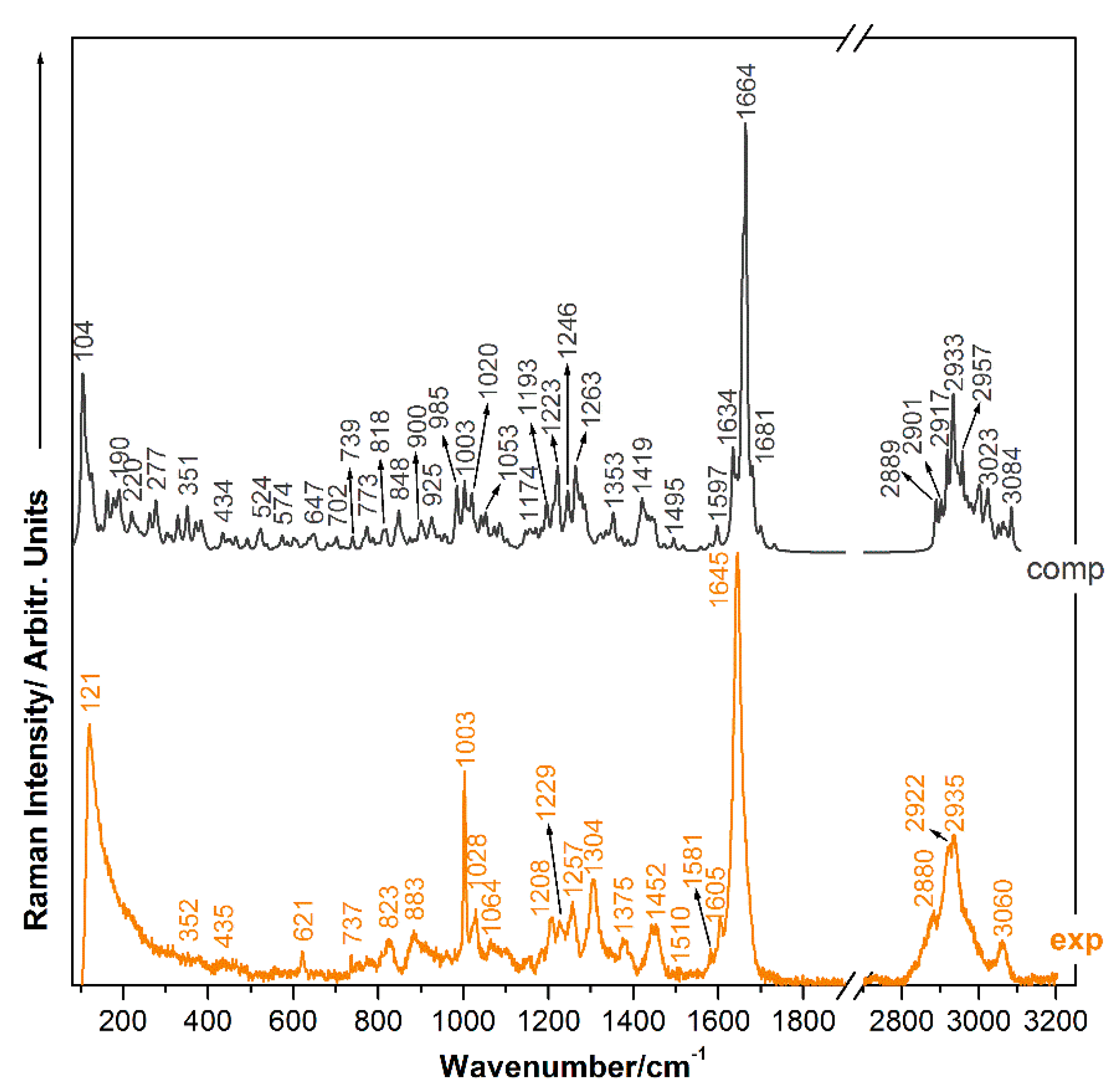
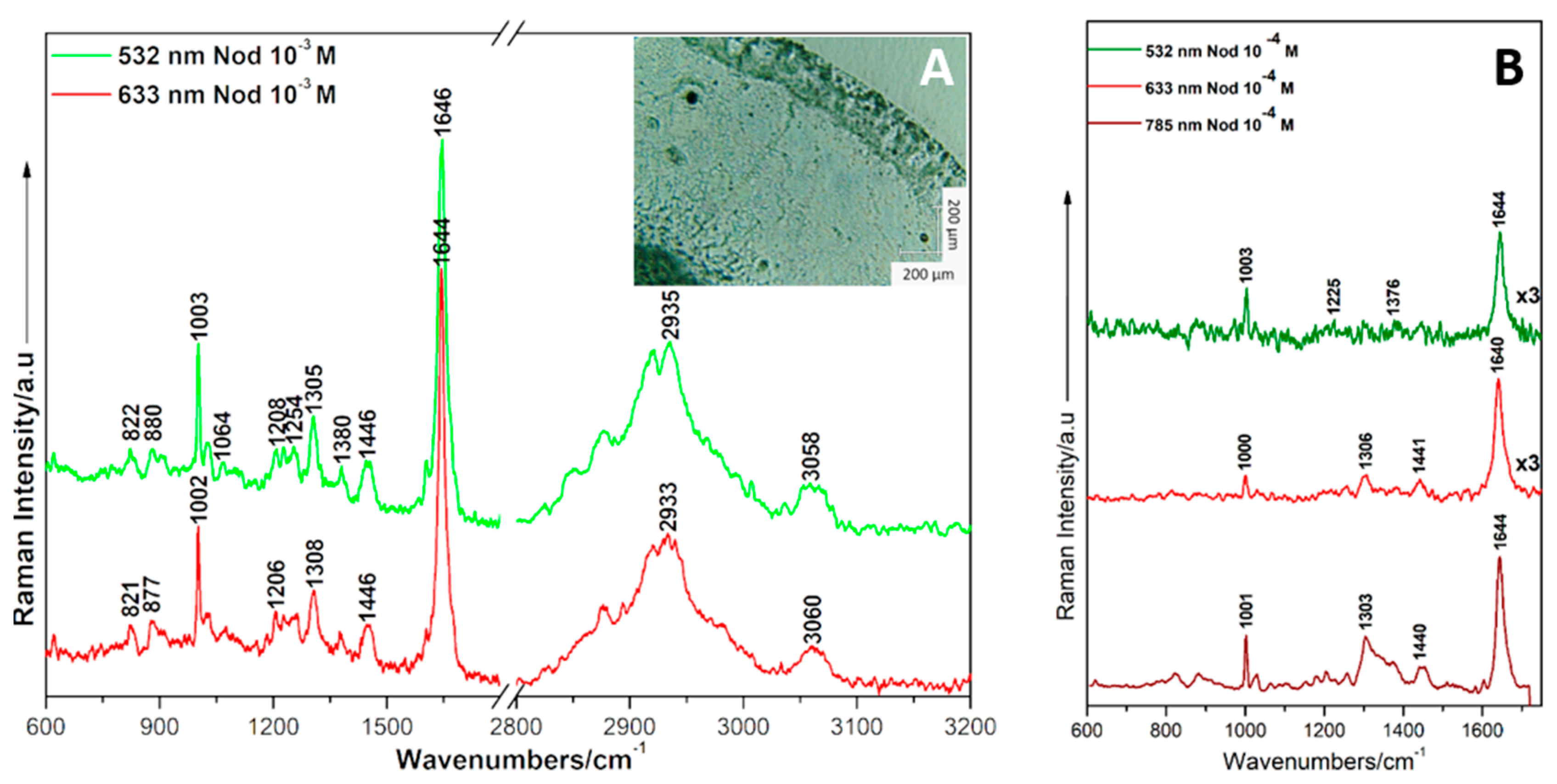
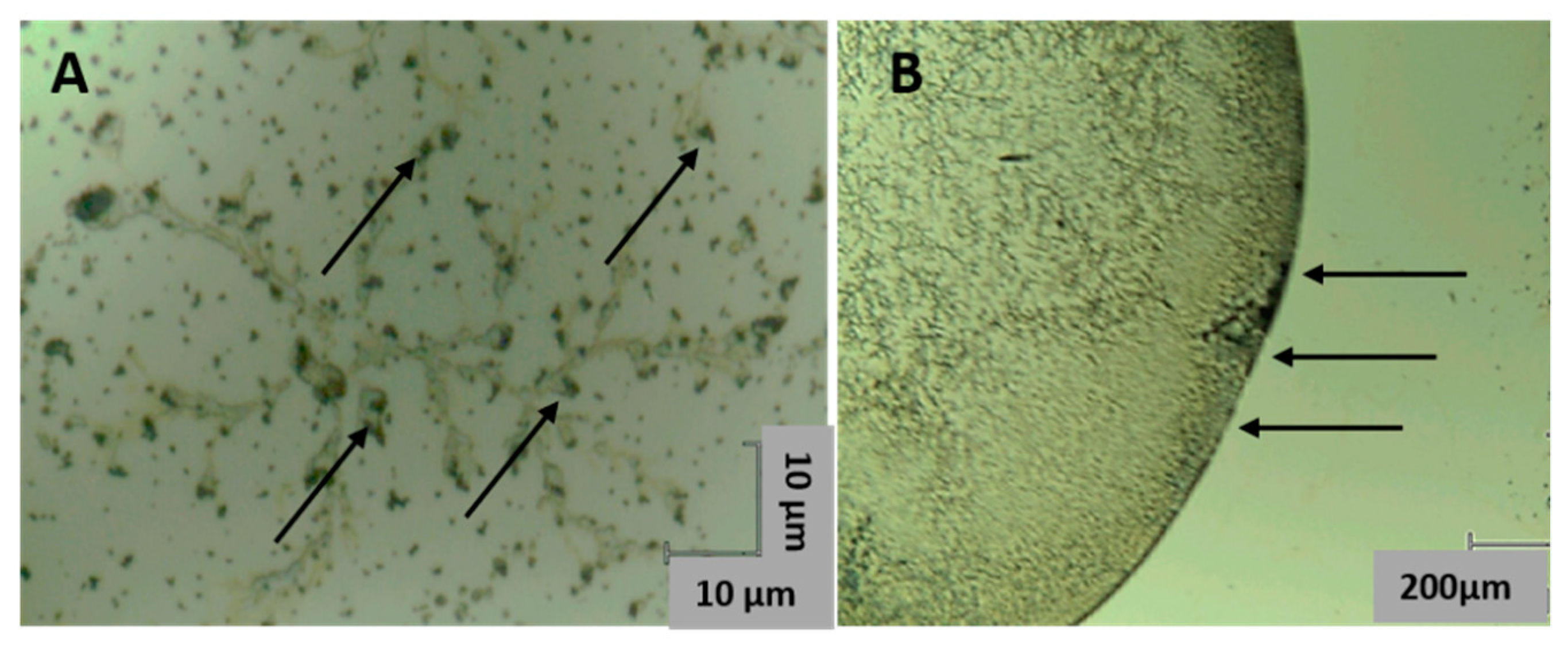
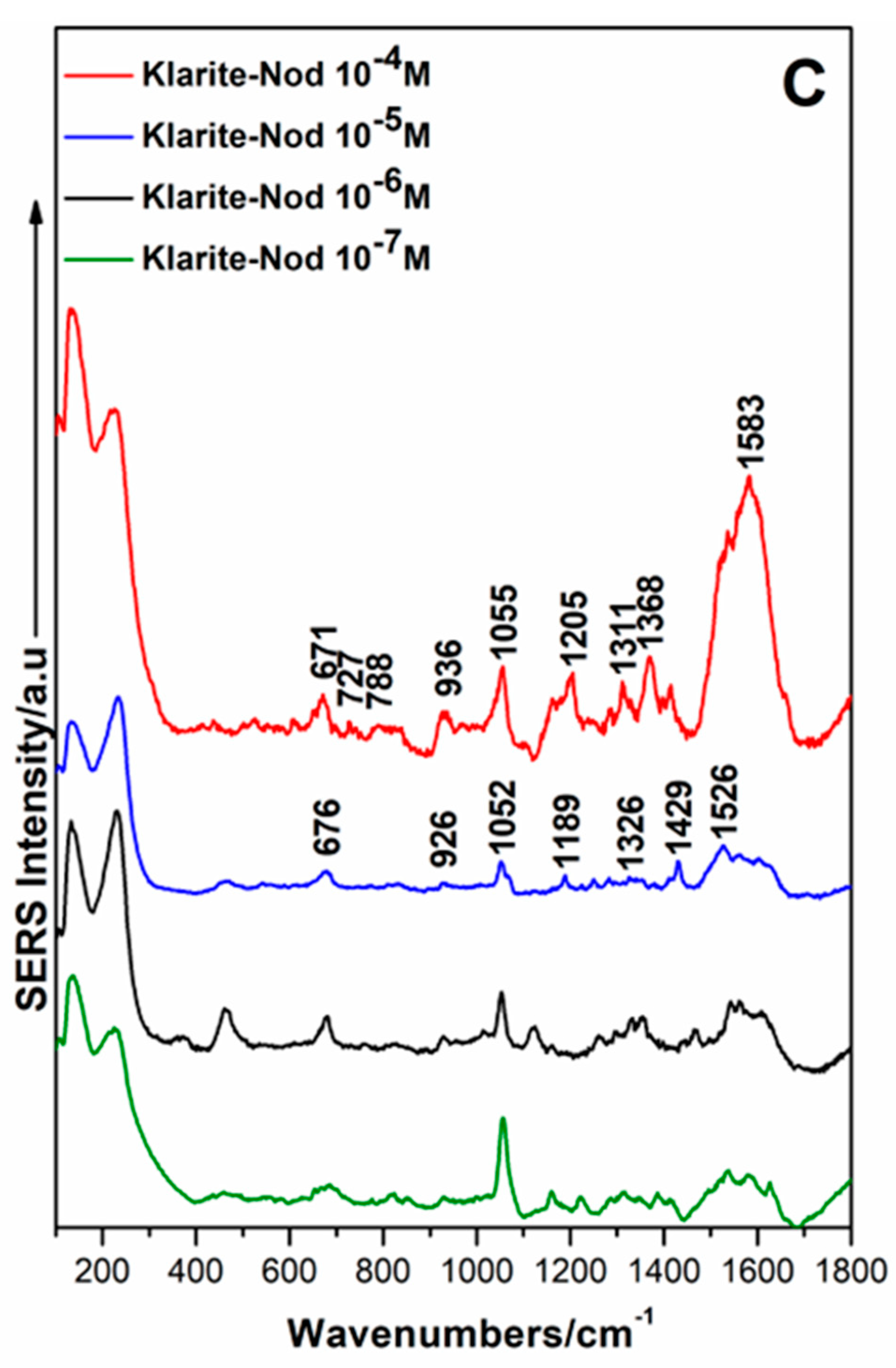
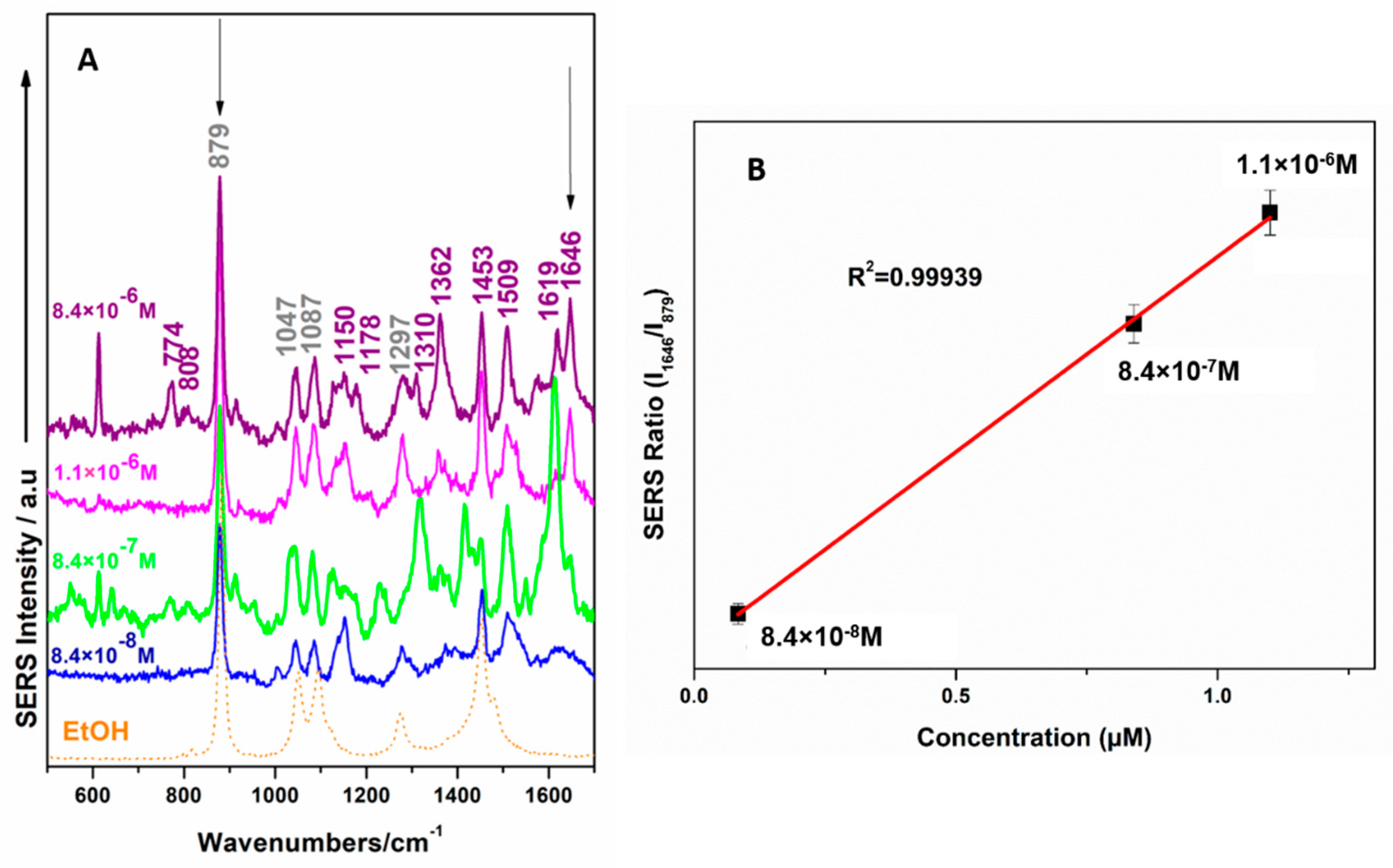
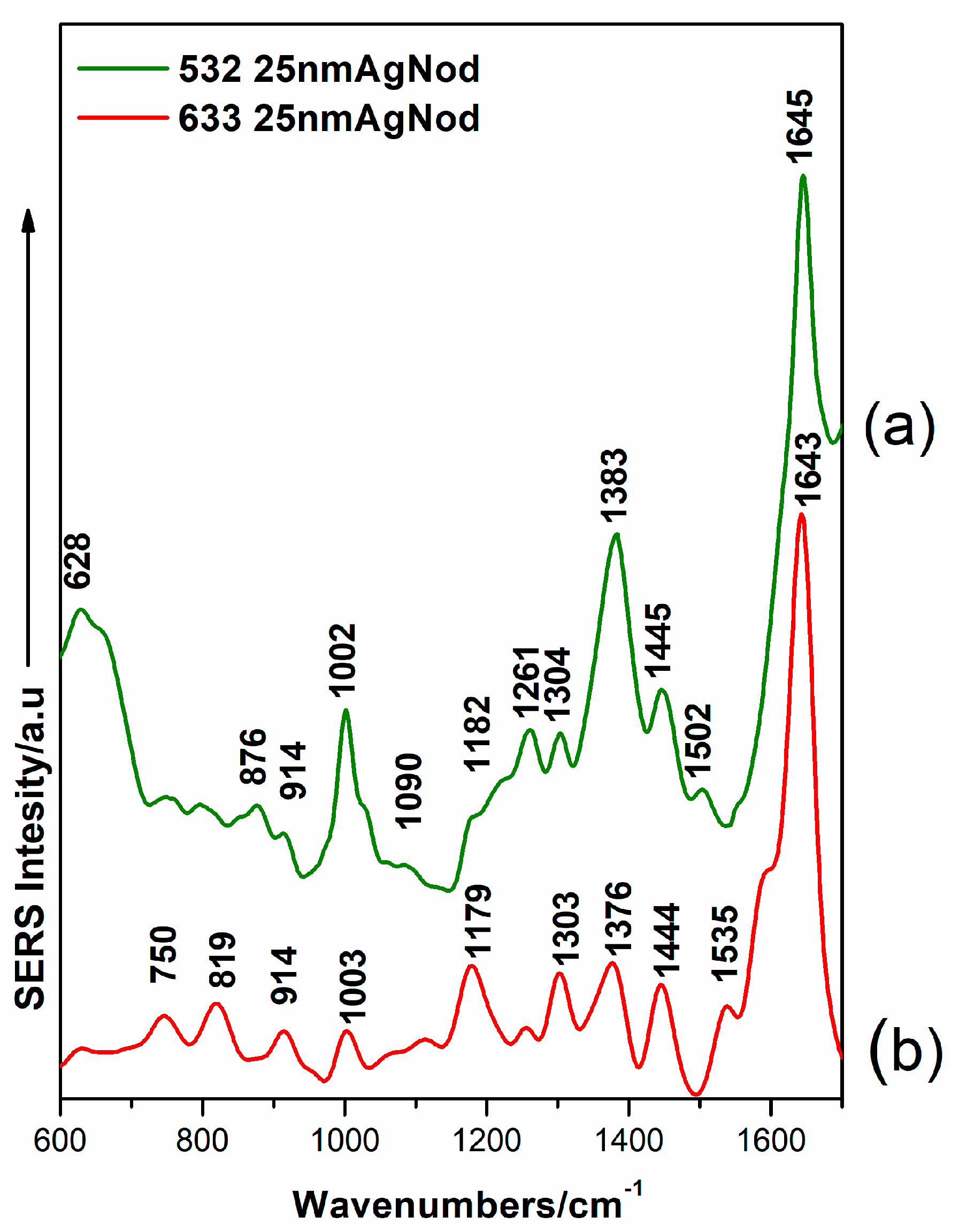

| Raman 633 nm | APFD/ 6-311+G(2d,p) | Assignments |
|---|---|---|
| 121 (s) | 104 | ρ(phenyl ring) + ρ(N28C27N29) |
| 133 | 125 | ρ(CH2) + γ(CH3) + γ(HN–C–NH) |
| 200 | ρ(CH3) | |
| 234 | 220 | ρ(CH3) + γ(HC–CH) |
| 261 | γ(CH3) + δ(CH2–CH2–CH2) + γ(OCNH) | |
| 277 | γ(CH3) + γ(HC = CH) | |
| 302 | γ(OCNH) | |
| 328 | δ(H3C–CH–CH) + δ(HC–CH–COOH) | |
| 351 | δ(H3C–O–CH | |
| 621 (vw) | 647 | β(CCC) in phenyl ring–in plane def. of phenyl ring + γ(O55H) |
| 737 (vw) | 739 | γ(N30H) + ω(C34H3) |
| 823 (vw) | 818 | ν(C3C11) + ρ(C4H2) + ω(C12H3) |
| 848 | ν(C4C5) + β(CCC) in phenyl ring–in plane def. of phenyl ring | |
| 883 (vw) | 900 | ν(C47C48) + ρ(C46H2) + ρ(C47H2) + β(C47C48H) |
| 1003 (s) | 985 | β(CCC) on phenyl ring–in plane def. of phenyl ring |
| 1003 | ω(CH3) | |
| 1028 (w) | 1020 | ω(CCC) + δ(CH)–on phenyl ring–in plane def. of phenyl ring |
| 1064 (vw) | 1043 | ν(C23C24) + ω(CH2) |
| 1053 | ν(C46C47) + ν(C47C48) + ω(CH3) + ω(CH2) | |
| 1100 (vw) | 1074 | ν(C22C23) + ν(C24C25) + β(C27N29H) + τ(N28H2) + ν(C52C53) + ω(C53H3) |
| 1085 | ω(CH3) + γ(OH) | |
| 1089 | ω(CH3) + γ(OH) + τ(C4H2) + δ(CH) on phenyl ring | |
| 1153 (vw) | 1157 | ω(C1H3) + τ(C4H2) + δ(CH) on phenyl ring |
| 1208 (vw) | 1193 | δ(CH) + δ(NH) + τ(CH2) |
| 1229 (vw) | 1223 | δ(C11H) + δ(C13H) + δ(C14H) + δ(C16H) + ν(C11C13) |
| 1257 (vw) | 1246 | ν(C57O58) + β(C57O58H) |
| 1304 (vw) | 1263 | ν(C33C35) + ν(C35N36) + δ(C33H) + δ(C35H) + δ(N36H) + δ(C40H) |
| 1264 | ν(C16C17) + δ(C16H) + δ(C17H) + δ(C52H) | |
| 1375 (vw) | 1353 | βip(C41H3) + δ(C40H) + βip(C43H3) |
| 1452 (vw) | 1419 | βoop(C41H3) + β(C46H2) |
| 1510 (vw) | 1495 | ν(37N36) + δ(N36H) |
| 1581 (vw) | 1597 | ν(CC) in phenyl ring |
| 1605 (w) | 1634 | ν(C37=O38) + ν(C39=C40) + β(C37N36H) |
| 1645 (vs) | 1664 | ν(C13=C14) + ν(C16=C17) |
| 1681 | ν(C39=C40) + ν(C37=O38) + ν(C57=C59) | |
| 1700 | ν(C57=O59) + β(C57O58H) + ν(C31=O32) + β(C31N30H) + β(C31C33H) | |
| 1732 | ν(C54=O56) + β(C54O55H) + β(C54C48H) | |
| 2880 (vw) | 2889 | νsym(C25H2) + νsym(C24H2) |
| 2901 | νsym(C1H3) + ν(C35H) | |
| 2922 (m) | 2917 | νsym(C14H3) |
| 2935 (m) | 2933 | νsym(C12H3) + νsym(C34H3) |
| 2957 | ν(C18H) | |
| 3001 | ν(C4H2) + νas(C12H3) + νas(O58H) + νas(C34H3) + ν(C42H2) | |
| 3023 | ν(O58H) + νas(C1H3) + νas(C12H3) + νas(C15H3) | |
| 3060 (vw) | 3084 | ν(CH) on phenyl ring |
| DCDR [54] | DCDR Technique/ Tienta SpectRIMTM 532/633 nm LOD = 10−4 M | Ag Sol LOD = 8.4 × 10−8 M | Ag Nanotrenches LOD = 10−3 M | KlariteTM LOD = 10−7 M |
|---|---|---|---|---|
| 621 m | 612 m | 621 m | 671 w | |
| 752 w | 736 w | 775 m | 750 m | 727 w |
| 834 m | 822 m/822 m | 819 m | ||
| 888 m | 883 m/880 m | 914 m | 936 m | |
| 1006 s | 1003 s/1002 s | 1002 s/1003 s | ||
| 1029 m | ||||
| 1069 m | 1064 w | 1055 s | ||
| 1090 m | ||||
| 1179 m | ||||
| 1182 m | ||||
| 1212 m | 1207 m/1208 m | 1205 s | ||
| 1259 m | 1256 m/1254 m | |||
| 1309 s | 1304 s/1308 s | 1303 m | 1311 m | |
| 1379 m | 1375m/1380 m | 1362 s | 1387 s | 1368 m |
| 1453 m | 1452 s/1446 m | 1452 s | 1453 s | 1415 m |
| 1509 m | ||||
| 1536/1582 w | 1535 w/1553 w | 1583 vs | ||
| 1648 s | 1645 s | 1647 s | 1645 s | 1656 s |
Publisher’s Note: MDPI stays neutral with regard to jurisdictional claims in published maps and institutional affiliations. |
© 2022 by the authors. Licensee MDPI, Basel, Switzerland. This article is an open access article distributed under the terms and conditions of the Creative Commons Attribution (CC BY) license (https://creativecommons.org/licenses/by/4.0/).
Share and Cite
Brezeștean, I.A.; Gherman, A.M.R.; Colniță, A.; Dina, N.E.; Müller Molnár, C.; Marconi, D.; Chiș, V.; David, I.-L.; Cîntă-Pînzaru, S. Detection and Characterization of Nodularin by Using Label-Free Surface-Enhanced Spectroscopic Techniques. Int. J. Mol. Sci. 2022, 23, 15741. https://doi.org/10.3390/ijms232415741
Brezeștean IA, Gherman AMR, Colniță A, Dina NE, Müller Molnár C, Marconi D, Chiș V, David I-L, Cîntă-Pînzaru S. Detection and Characterization of Nodularin by Using Label-Free Surface-Enhanced Spectroscopic Techniques. International Journal of Molecular Sciences. 2022; 23(24):15741. https://doi.org/10.3390/ijms232415741
Chicago/Turabian StyleBrezeștean, Ioana Andreea, Ana Maria Raluca Gherman, Alia Colniță, Nicoleta Elena Dina, Csilla Müller Molnár, Daniel Marconi, Vasile Chiș, Ioan-Leontin David, and Simona Cîntă-Pînzaru. 2022. "Detection and Characterization of Nodularin by Using Label-Free Surface-Enhanced Spectroscopic Techniques" International Journal of Molecular Sciences 23, no. 24: 15741. https://doi.org/10.3390/ijms232415741
APA StyleBrezeștean, I. A., Gherman, A. M. R., Colniță, A., Dina, N. E., Müller Molnár, C., Marconi, D., Chiș, V., David, I.-L., & Cîntă-Pînzaru, S. (2022). Detection and Characterization of Nodularin by Using Label-Free Surface-Enhanced Spectroscopic Techniques. International Journal of Molecular Sciences, 23(24), 15741. https://doi.org/10.3390/ijms232415741













